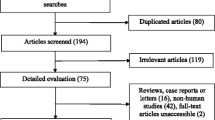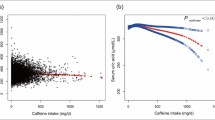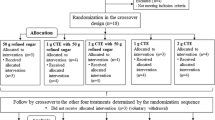Abstract
Introduction/objectives
Alcohol consumption is associated with hyperuricemia and gout. Previous studies have indicated a role for green tea catechins in uric acid (UA) metabolism. This study aimed to elucidate the acute effect of green tea catechins in terms of enhancing urinary excretion of UA and xanthine/hypoxanthine (Xa/HX; UA precursors) after alcohol ingestion.
Methods
In a randomized crossover study, ten healthy Japanese subjects consumed test meals, including a Japanese distilled spirit (Shōchū) with water (SW) or Shōchū with catechin-rich green tea (SC), each containing 20 g of alcohol. The SC contained 617 mg of catechin in total. Serum and urine UA and Xa/HX concentrations were measured. Blood samples were collected after 2.5 h, and urine samples were collected between 0 and 5 h after consuming the test meal.
Results
Urine UA and Xa/HX excretions were significantly higher in the SC group than in the SW group (UA: SW, 0.45 ± 0.08; SC, 0.52 ± 0.09; Xa/HX: SW, 0.08 ± 0.04; SC, 0.16 ± 0.05 mg/kg/h). UA clearance (CUA) and fractional UA excretion (FEUA) tended to increase more in the SC group than in the SW group (CUA: SW, 7.76 ± 2.14; SC, 8.75 ± 2.23 mL/min/1.73 m2; FEUA: SW, 6.08 ± 1.36; SC, 6.64 ± 1.42%). No significant differences in serum UA and Xa/HX concentrations were observed between two groups.
Conclusions
It was concluded that green tea catechins can enhance the excretion of UA and Xa/HX, even though alcohol is ingested.
Trial registration number
UMIN000040076. Retrospectively registered 7 April 2020. https://upload.umin.ac.jp/cgi-open-bin/ctr/ctr_view.cgi?recptno=R000045687
Key Points • Green tea catechins enhance the excretion of uric acid and xanthine/hypoxanthine, even when alcohol is ingested simultaneously. • In case of non-adherence of limiting alcohol intake, catechin-rich green tea may be an effective dietary component to continue dietary therapy. |


Similar content being viewed by others
Data availability
Data that support the findings of this study are available from the corresponding author upon reasonable request.
Code availability
Not applicable
Abbreviations
- UA:
-
Uric acid
- HX:
-
Hypoxanthine
- Xa:
-
Xanthine
- XO:
-
Xanthine oxidase
- SD:
-
Standard deviation
- BMI:
-
Body mass index
- SW:
-
Shōchū with water
- SC:
-
Shōchū with catechin-rich green tea
- Cre:
-
Creatinine
- Ccr:
-
Creatinine clearance
- FUA :
-
Filtered uric acid load
- CUA :
-
Uric acid clearance
- U-UA excretion:
-
Urinary uric acid excretion per kilogram of body weight per hour
- FEUA :
-
Renal fractional uric acid excretion
- FXa/HX :
-
Filtered Xa/HX load
- CXa/HX :
-
Xa/HX clearance
- U-Xa/HX excretion:
-
Urinary Xa/HX excretion per kilogram of body weight per hour
- FEXa/HX :
-
Renal fractional Xa/HX excretion
- URAT1:
-
Urate anion transporter 1
- OAT:
-
Organic anion transporters
References
Ministry of Health, Labour and Welfare (2016) The outline of the results of National Livelihood Survey. (in Japanese). https://www.mhlw.go.jp/toukei/saikin/hw/k-tyosa/k-tyosa16/index.html. Accessed 29 Sep 2020
Jalal DI, Chonchol M, Chen W, Targher G (2013) Uric acid as a target of therapy in CKD. Am J Kidney Dis 61:134–146
Niskanen LK, Laaksonen DE, Nyyssönen K, Alfthan G, Lakka HM, Lakka TA, Salonen JT (2004) Uric acid level as a risk factor for cardiovascular and all-cause mortality in middle-aged men: a prospective cohort study. Arch Intern Med 164:1546–1551
Choi HK, Ford ES (2007) Prevalence of the metabolic syndrome in individuals with hyperuricemia. Am J Med 120:442–447
Zhang W, Iso H, Murakami Y, Miura K, Nagai M, Sugiyama D, Ueshima H, Okamura T, EPOCH-JAPAN GROUP (2016) Serum uric acid and mortality form cardiovascular disease: EPOCH-JAPAN Study. J Atheroscler Thromb 23:692–703
Uedono H, Tsuda A, Ishimura E, Nakatani S, Kurajoh M, Mori K, Uchida J, Emoto M, Nakatani T, Inaba M (2017) U-shaped relationship between serum uric acid levels and intrarenal hemodynamic parameters in healthy subjects. Am J Physiol Renal Physiol 312:F992–F997
Choi HK (2010) A prescription for lifestyle change in patients with hyperuricemia and gout. Curr Opin Rheumatol 22:165–172
Rho YH, Zhu Y, Choi HK (2011) The epidemiology of uric acid and fructose. Semin Nephrol 31:410–419
Wang M, Jiang X, Wu W, Zhang D (2013) A meta-analysis of alcohol consumption and the risk of gout. Clin Rheumatol 32:1641–1648
Yamamoto T, Moriwaki Y, Takahashi S (2005) Effect of ethanol on metabolism of purine bases (hypoxanthine, xanthine, and uric acid). Clin Chim Acta 356:35–57
Ka T, Moriwaki Y, Inokuchi T, Yamamoto A, Takahashi S, Tsutsumi Z, Yamamoto T (2006) Effects of allopurinol on beer-induced increases in plasma concentrations and urinary excretion of purine bases (uric acid, hypoxanthine, and xanthine). Horm Metab Res 38:188–192
Sang S, Lambert JD, Ho CT, Yang CS (2011) The chemistry and biotransformation of tea constituents. Pharmacol Res 64:87–99
Chen G, Tan ML, Li KK, Leung PC, Ko CH (2015) Green tea polyphenols decreases uric acid level through xanthine oxidase and renal urate transporters in hyperuricemic mice. J Ethnopharmacol 175:14–20
Zhu C, Xu Y, Liu ZH, Wan XC, Li DX, Tai LL (2018) The anti-hyperuricemic effect of epigallocatechin-3-gallate (EGCG) on hyperuricemic mice. Biomed Pharmacother 97:168–173
Li F, Liu Y, Xie Y, Liu Z, Zou G (2020) Epigallocatechin gallate reduces uric acid levels by regulating xanthine oxidase activity and uric acid excretion in vitro and in vivo. Ann Palliat Med 9:331–338
Jatuworapruk K, Srichairatanakool S, Ounjaijean S, Kasitanon N, Wangkaew S, Louthrenoo W (2014) Effects of green tea extract on serum uric acid and urate clearance in healthy individuals. J Clin Rheumatol 20:310–313
Zhang Y, Cui Y, Li XA, Li LJ, Xie X, Huang YZ, Deng YH, Zeng C, Lei GH (2017) Is tea consumption associated with the serum uric acid level, hyperuricemia or the risk of gout? A systematic review and meta-analysis. BMC Musculoskelet Disord 18:95
Wu XW, Muzny DM, Lee CC, Caskey CT (1992) Two independent mutational events in the loss of urate oxidase during hominoid evolution. J Mol Evol 34:78–84
Japanese Society of Gout and Nucleic Acid Metabolism Guideline Revisory Committee (ed) (2019) Revised guideline for the management of hyperuricemia and gout. Shindan To Chiyo Sha Co Ltd, Tokyo. (in Japanese)
Perez-Ruiz F, Calabozo M, Erauskin GG, Ruibal A, Herrero-Beites AM (2002) Renal underexcretion of uric acid is present in patients with apparent high urinary uric acid output. Arthritis Rheum 47:610–613
Xu L, Shi Y, Zhuang S, Liu N (2017) Recent advances on uric acid transporters. Oncotarget 8:100852–100862
Enomoto A, Kimura H, Chairoungdua A, Shigeta Y, Jutabha P, Ho Cha S, Hosoyamada M, Takeda M, Sekine T, Igarashi T, Matsuo H, Kikuchi Y, Oda T, Ichida K, Hosoya T, Shimokata K, Niwa T, Kanai Y, Endou H (2002) Molecular identification of a renal urate anion exchanger that regulates blood urate levels. Nature 417:447–452
Panza VS, Wazlawik E, Ricardo Schütz G, Comin L, Hecht KC, da Silva EL (2008) Consumption of green tea favorably affects oxidative stress markers in weight-trained men. Nutrition 24:433–442
Takahashi M, Miyashita M, Suzuki K, Bae SR, Kim HK, Wakisaka T, Matsui Y, Takeshita M, Yasunaga K (2014) Acute ingestion of catechin-rich green tea improves postprandial glucose status and increases serum thioredoxin concentrations in postmenopausal women. Br J Nutr 112:1542–1550
Van Amelsvoort JM, Van Hof KH, Mathot JN, Mulder TP, Wiersma A, Tijburg LB (2001) Plasma concentrations of individual tea catechins after a single oral dose in humans. Xenobiotica 31:891–901
Rietveld A, Wiseman S (2003) Antioxidant effects of tea: evidence from human clinical trials. J Nutr 133:3285S–3292S
Maughan RJ, Griffin J (2003) Caffeine ingestion and fluid balance: a review. J Hum Nutr Diet 16:411–420
Seal AD, Bardis CN, Gavrieli A, Grigorakis P, Adams JD, Arnaoutis G, Yannakoulia M, Kavouras SA (2017) Coffee with high but not low caffeine content augments fluid and electrolyte excretion at rest. Front Nutr 4:40
Akizuki S (1982) Serum uric acid levels among thirty-four thousand people in Japan. Ann Rheum Dis 41:272–274
Dalbeth N, Phipps-Green A, House ME et al (2015) Body mass index modulates the relationship of sugar-sweetened beverage intake with serum urate concentrations and gout. Arthritis Res Ther 17:263
Dalbeth N, Allan J, Gamble GD, Horne A, Woodward OM, Stamp LK, Merriman TR (2020) Effect of body mass index on serum urate and renal uric acid handling responses to an oral inosine load: experimental intervention study in healthy volunteers. Arthritis Res Ther 22:259
Acknowledgements
We are grateful to the volunteers who participated in the study.
Funding
This study was supported by a Grant-in-Aid for Scientific Research (C) 19 K11670 from the Ministry of Education, Culture, Sports, Science and Technology in Japan (awarded to HA).
Author information
Authors and Affiliations
Contributions
YK and HA conceived the research idea and designed the study. YK, AY, MH, MA, and TA collected, analyzed, and interpreted the data. YK and AY drafted the manuscript. TA and TH contributed significant advice. HA edited the manuscript. All the authors contributed to revisions of the manuscript and reviewed the final version.
Corresponding author
Ethics declarations
Disclosures
None.
Ethics approval
The protocol was approved by the Ethics Committee of the University of Shizuoka.
Consent to participate
The purpose of the study was explained to the participants, and the present study was performed after obtaining written informed consent.
Consent for publication
Prior to data collection, the purpose of the study was explained to the participants and their informed consent was recorded.
Additional information
Publisher’s note
Springer Nature remains neutral with regard to jurisdictional claims in published maps and institutional affiliations.
Rights and permissions
About this article
Cite this article
Kawakami, Y., Yasuda, A., Hayashi, M. et al. Acute effect of green tea catechins on uric acid metabolism after alcohol ingestion in Japanese men. Clin Rheumatol 40, 2881–2888 (2021). https://doi.org/10.1007/s10067-021-05625-7
Received:
Revised:
Accepted:
Published:
Issue Date:
DOI: https://doi.org/10.1007/s10067-021-05625-7




